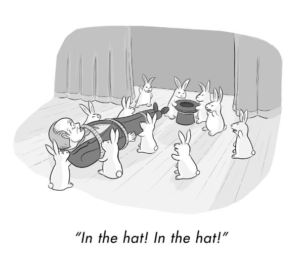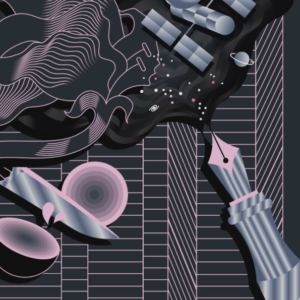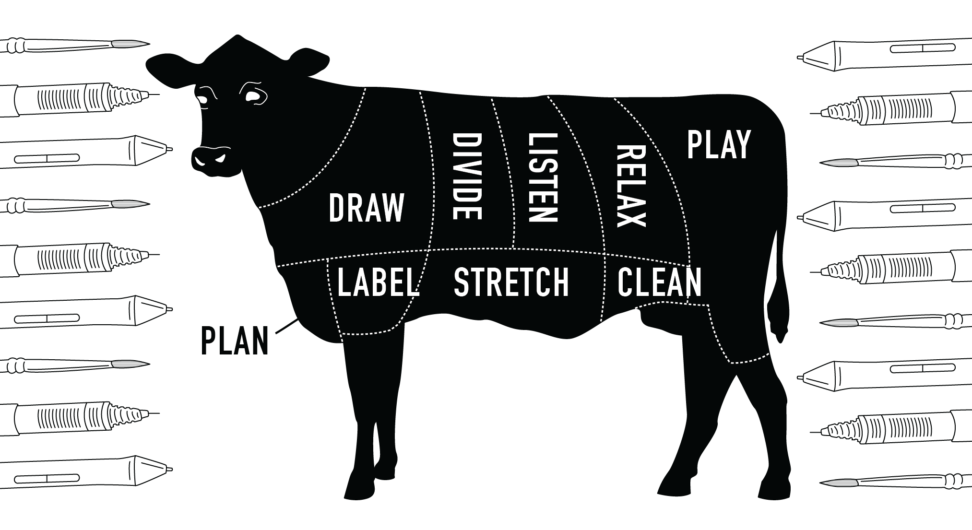3 Kickass Illustrators Answer 10 Questions. (On Productivity, Planning & Pet Peeves)
Last time around we learned what a few of my favorite (and most delightfully insightful) illustrators do when they first wake up and right before they go to bed, to set themselves up for a successful day, but what about all that time in between? I had a sense they would have some more suggestions I and others would like to turn into habits.
This time, I sent a bunch of questions about structuring their time, taking breaks, keeping their workspace workable and more, and asked them to answer the ones that resonated most. Their responses are honest, helpful and surprisingly encouraging―read them and you’ll find out you’re not a worthless pile of freelance garbage. Hooray!
Oh, and I jumped in on this one too. Which is a little messed up since I made up the questions. (Although whatever, not the most egregious nepotism we are currently witnessing). But I feel like I have some weird tips to share as well.
If you haven’t already, get it together and follow these folks on Instagram:
- LIBBY: @libbyvanderploeg
- ANA: @anakova_
- ELLIS: @ellisjrosen
And now, a glimpse into their minds.
——————————————————————————————————————————

1. How do you work with (rather than against) your natural clock? What permissions do you give yourself/what expectations do you set?
LIBBY: Since I’m an early riser, I start working typically by 8 am (sometimes earlier), and allow my brain and body a little more freedom as the day goes on. I try to turn in things with deadlines before noon on the due date, so I can enjoy the rest of the day at a more leisurely pace.
VAL: I try not to put myself in a position to ever have to draw in the morning―I just know it’s going take much longer and suck much more.
I knock out the admin and life tasks in the first part of the day so I don’t feel like they’re hanging over my head and then I get cracking on creative stuff in the afternoon.
2. How do you know when it’s time to take a break? (Which indicators do you listen to vs ignore)?
LIBBY: I know it’s time to take a break when I feel my body start to curl up like a crumpled piece of paper. I break every 30 mins to 1 hour. I try to sprinkle in outside errands throughout the day so I don’t get stuck in tunnel vision. I’m pretty good at staying on task, so I really need to remind myself to get up and away from my work.
ELLIS: If I feel tired or anxious it’s time for a break. I can feel it physically: my body temperature rises and I tighten up. My doctor insists there’s something else going on, but what does he know? When I feel like this, taking a break can quickly re-energize me. I’m always one dog-walk away from a few hours of concentrated work. Taking breaks is part of the whole process, you can’t make good work without them. Even the most type-A, fast-talking, mover-and-shaker hotshot needs re-fueling. They also need a cool catch phrase.
I try to sprinkle in outside errands throughout the day so I don’t get stuck in tunnel vision.
VAL: If I’m working from home I generally keep from showering until I hit a point at which I need a break. I find that by the end of my shower I’ve either overcome a stumbling block or just had a full on epiphany, which rules.
3. How do you manage longer or overlapping deadlines/structure your time?
LIBBY: I’m pretty good at estimating how long it will take to create a first draft of something, although once in a while I’ll be surprised to find a simple project might take 3x the normal length of time to complete. I block the time estimates into my google calendar once a project is booked so that I don’t overextend myself. Once in I while I end up with some free time or I have to pull an all-nighter. But that’s often the nature of freelance anyway.
ELLIS: I am not so good with overlapping projects. I generally separate them and knock out the one that has a closer deadline. When I have a long term project I don’t usually seek out other projects, which is why I’ll never be that type-A hotshot I told you about before. My time-lines are scribbled out on scrap paper and quickly forgotten about. There’s only one rule that I need: cut down any project into smaller steps. As long as I’m doing this and I have a general idea of much work I need to finish before a deadline, I’m fine. Some nights are later than others, sometimes it feels a bit down to the wire, but that’s always going to be the case. Plus, this process allows for unknown variables which always pop up. God laughs at the best laid plans, which is a proverb that I just made up right now.
4. How do you manipulate / organize / control your work environment to maximize productivity?

ELLIS: Gotta clean the ole home office every other week or so. Which is to say it’s not clean-but my standards are so low that the slightest bit of tidying up makes me feel like I have a whole new office. It’s a similar feeling to when you get rid of a couple of tabs on your browser. It’s like you’ve made space for a whole new world of funny animal videos.
It’s a similar feeling to when you get rid of a couple of tabs on your browser. It’s like you’ve made space for a whole new world of funny animal videos.
ANA: Keeping a surgically barebones workspace helps. My desk is white and I keep it totally cleared except for my laptop, screen, and Wacom tablet. And my coffee cup or water jar. Any stationery or random desk tidbits go on shelves or in drawers. Not seeing any clutter helps me focus. I keep my door closed.
Sometimes, especially if I’m working on something that’s purely illustration, I love to listen to audiobooks as I work. Doing so also makes me feel like I’m hacking time. Which then makes me feel smug. Which then helps me make more confident artistic choices. (Or so I tell myself).
VAL: I get a kick out of rearranging my furniture & desk periodically (you can always change it back) but the biggest bang for my buck has been rerouting my electronics cords. I relegated them to under my desk and as out of my way as possible and it has changed my life. I also keep a drawing/painting pad handy even when doing more administrative tasks because you never know when your brain will chance to work out a new idea or your hands will generate a little mark that you can turn into something bigger later.
5. How do you stay on track and keep making work when nothing is “working”? What things do you remind yourself of?
LIBBY: You just keep working, haha 🙁 . If you have a deadline you have to meet, then there’s often little alternative. If I don’t love the work, then I might cross my fingers and hope that the art director or creative director might have some good suggestions for me as to how to strengthen what I’m working on. The key for me has often been to build enough time into the project schedule to allow for distance. Often when I step away from something that’s not working, I will start to come up with solutions. Fresh air and exercise can be really good ways to recalibrate the brain.

ANA: If something is not working or I’m floundering confusedly, usually it’s because a project is too large and nebulous, and I need to chew it up for myself into smaller chunks. I’ll need to create a much more granular list of steps to follow, or a fill-in-the-blanks map of items I need to complete. Once I see the list of steps, or the visual map of blanks to fill in, it becomes more clear to me where to start (1), and roughly how long certain sections might take (2). Once I feel like know these two things, I’m usually able to move past any mental block I might be having.
6. How do you find time to work on your own projects in the midst of client work? What is the accountability mechanism for making sure your own personal projects are progressing as well?
LIBBY: If I start to feel myself drifting aimlessly with nothing creative to share, I get really down. When those feelings start to creep in, I allow myself at least a half day for creative play. That’s when I usually make my silly gifs. I have lots of ideas written down waiting to be realized, and I feel better all over when I bring those ideas to life. If all that I’m making is client-based work, then I’ll never grow. I think it’s good to share work that you’re a little insecure about. Sometimes the feedback, be it positive or negative, can be really enlightening!
I think it’s good to share work that you’re a little insecure about. Sometimes the feedback, be it positive or negative, can be really enlightening!
ANA: I have a grid of 4 cork boards on the wall next to my desk, where I pin up my rough weekly plans (8ish weeks forward though it changes a lot) and sometimes random reminders and sketch ideas, or occasionally mementos.
I use small squares of colored paper that kinda look like post-its. I like having a physical visual map of my plans and responsibilities, so I’ll end up casually glancing at it multiple times throughout the day (rather than something that’s segmented and obscured inside a digital screen/app).
VAL: I try to ask for something “extra” every day. My mom always says that “if you don’t knock, no one will answer” and there are so many no’s in freelance that you need to keep the asking frequency up in order to get to your yes’s. Chasing bigger and better opportunities drives your skill growth and progress.
7. How do you stay social (particularly if you work from home)?
ANA: Sometimes other freelancerish friends come over and we sit in the same room and work in silence. We call it being cats together. Occasionally I go out for dancing marathons, but lately my hedonism is in remission. Mostly I’m trying to cultivate a fertile creative solitude, as recommended by various literary and artistic titans.
Sometimes other freelancerish friends come over and we sit in the same room and work in silence.
VAL: I accord socializing the same status as work in my calendar and use the same google calendar for both. I straight up schedule my diversions. Nobody wants to talk about this, but fun takes work.
8. Biggest productivity pet peeve?
LIBBY: I don’t like it when people email me about non-urgent projects over the weekend. We have technology. Use it. Draft that shit and send during normal business hours.
ELLIS: When I take forever to answer an e-mail, it’s understandable because, hey, it’s life. When I’m waiting for someone to respond to me and they take forever, HOW DARE THEY. Also, please don’t humble-brag online about how much work you have/how late you are staying up to work. Whatever satisfaction you gain from it is not worth making others feel like they don’t work hard enough.
VAL: ? . To both of the above.
9. Weirdest thing that you do to stay productive?
LIBBY: Loud, guttural stretches.
VAL: Same as Libby: stretching in public to get my blood flowing again. I like to make sure I turn my head upside down and while I’m doing that I try to remember that physiologically speaking, everyone else is weird for not stretching, much moreso than I am weird for sticking my ass in their face at the coffee shop.
10. Productivity/organizational thing that to you is so obvious but other people have not caught onto yet and you wish they just would already?
LIBBY: When it comes to digital work, you gotta keep those layers LABELED and ORGANIZED in folders! At some point you’ll be glad you did.
ELLIS: Just remember to cut yourself some slack. If you ever feel like you aren’t productive enough, your work’s not good enough, other people’s careers are going better, or anything else that gives you anxiety, try to remember that feeling bad about it doesn’t fix anything. I engage in self-pity way too often, and it always makes everything worse. I know that for many, anxiety isn’t something that can be turned off, but if possible, try not to be too hard on yourself. Focus on your own career, stay away from people that make you feel bad and invest in a good dog. Cats don’t cut it these days. Shots fired, internet.
VAL: Don’t send email responses prematurely: just wait until you have all the necessary information at hand and are actually ready to respond, and then send it. Or, if you must respond immediately, just explain that you’ll write a more complete/thoughtful response when you have all the info you need. So many back-and-forth emails about nothing could be avoided!
11. Create your own question!
LIBBY:
Fill in the blank: “I’d rather be _______”
-more carefree and haphazard, but baby I was born this way.
And that, friends, is a perfect note to end on. Remember that you are a glorious, ascendant freelance phoenix but there’s always more that you can learn… and teach. Leave us your best tips for a productive and balanced workday in the comments.
This work is licensed under a Creative Commons Attribution-ShareAlike 4.0 International License.


